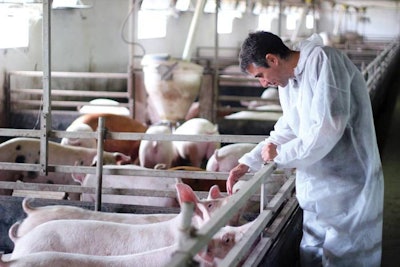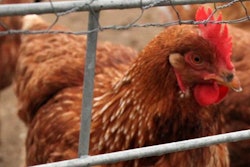
This article appears in the August/September issue of Feed International. View all of the articles in the digital edition of this magazine.
Experts agree that the responsible use of antibiotics in animal production must be promoted worldwide and other methods should be employed to minimize the incidence of diseases that require antibiotic treatment.
There are ways poultry and pig producers can reduce antibiotic use on their farm by focusing on practical ways to support immunity and improve biosecurity.
Trends in antibiotic use
Despite legislation and concern over resistance, the use of antibiotics in agriculture it is set to rise over the next 15 years. This is largely due to the increased production animal population – fueled by the demand for meat. Already countries, including the U.S., have see the amount of antibiotics sold for agricultural use increase by more than 10 percent over the past five years.
In Europe, there is a threat of further legislation on the use of antibiotics. Officials want to stop their use as a preventative measure and limit collective treatment. For the poultry industry in particular, limiting prophylactic use to individual animals is serious concern.
Simply removing antibiotics from agriculture is not the answer. Increased disease incidence and welfare issues have been reported in countries where bans were imposed.
Since the 2006 ban on the use of antibiotic growth promoters in Europe, producers there have gone through a steep learning curve. They have had to look closely at all aspects of production, in order to reduce disease incidence.
Practical measures
Much of the improvements made have been on biosecurity protocols and management techniques. Most farms now have good external biosecurity, wheel sprays for vehicles, and footbaths and protective clothing for visitors. However, internal biosecurity can still be improved. Personnel and tools moving between units can transfer pathogens, and poor hygiene leads to challenges from other animals, feed and bedding. Producers have also looked at reducing stocking density and improving air quality to reduce stress.
Nutrition has also been a focus. Changes in specification and raw materials can create a diet that results in more robust animals.
For example, supplying high-quality protein and well-digested ingredients to young animals encourages optimum development of the gastrointestinal tract (GIT). This in turn means that they are less susceptible to enteric disease. There are also numerous products on the market that have been designed to either support immunity, reduce pathogen load, or have other modes to action that promote health.
On-farm monitoring
A recent paper in the International Animal Health Journal (IAHJ) looked at the effectiveness of an audit program that evaluates various factors that contribute to productivity on pig farms. These included biosecurity, animal health status, mycotoxin exposure and antimicrobial use. The aim was to identify animal health challenges, which could then be targeted and minimized.
The on-farm monitoring included scoring for external and internal biosecurity threats, followed by comparisons with other units and ranking of the measures used.

In an effort to reduce antibiotics usage, audit programs can help aid in a decrease in biosecurity threats on the farm. | Zoe Kay
From this process, the researchers had several general recommendations to improve biosecurity. A quarantine area should be set up and all gilts should be kept away from the main herd for three weeks to ensure they are free of disease. The cleanliness of drinking water is another area that is often overlooked and a potential vector for disease. Water quality should be tested and treatment considered, particularly for those relying on a borehole supply. It was concluded that the problem areas identified were inhibiting animal performance and health, hence increasing reliance on antibiotics.

Quarantine areas for purchased stock should be set up on all farms to check for any incubating disease and offer treatment, before mixing with the rest of the farm.
In-feed solutions
There are many products sold for pigs and poultry that are marketed to improve health and performance. Their aim is to also reduce the need for antibiotics, saving producers money and contributing to lower usage targets. Modes of action include supporting immunity and improving gut health, as well as having direct antimicrobial action.
Probiotics, competitive exclusion and functional carbohydrates are products that focus on improving gut health. The principle is that if the integrity and microbial balance of the GIT can be maintained, then animals will be better able to resist disease challenges. At the same time, by optimizing gut function, feed conversion and growth rates are improved. And as the gut is key to immunity, modulating responses can also help to reduce the need for antibiotics.
The microbial imbalance dysbacteriosis became commonplace in the European poultry industry after the ban on antibiotic growth promoters. Changes in the composition of the gut microflora have been associated with deterioration in intestinal function as measured by feed conversion efficiency. Visible improvements in gut health scores have been demonstrated when feeding functional carbohydrates. These effects are often mirrored by performance benefits in terms of growth and feed efficiency.
Nutritional solutions have also been shown to increase the sensitivity of bacteria to antibiotics. A study fed a natural carbohydrate fraction to finishing pigs in combination with a commercial antibiotic program. After feeding the product to pigs for seven months, an increased sensitivity of E. coli to several antibiotics was noted. Performance, as measured by ADG and EPFP, was also improved.
Biosecurity plays large part in AB reduction
As previously stated, while agriculture isn’t the biggest culprit in the war on antibiotic resistance, it is a highly visible one. Anything that can be done to reduce usage will help with the image of pig and poultry production. At the same time, increased focus on biosecurity and hygiene can only be of benefit to animal health and welfare. As vaccination technology improves, there are cost-effective ways of preventing disease and responding to new threats and outbreaks. The scientific community is working on ways to prevent resistance and even develop new antibiotics. There are successful nutritional solutions to help support animal productivity and health.
In order to limit the development of antimicrobial resistance, it is still important to promote responsible use of antibiotics in order to preserve them for future generations. However, there are times when vets need to prescribe antibiotics in order to maintain the welfare and prevent deaths of the animals under their care. The ideal would be for disease challenges to be predicted and, as such, on-farm diagnostic technologies are being developed. In this way, outbreaks could be prevented before the use of antibiotics became necessary.
References available on request
















